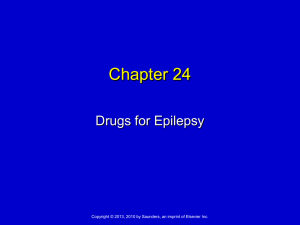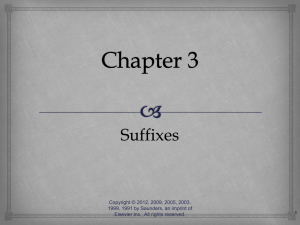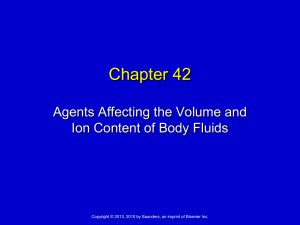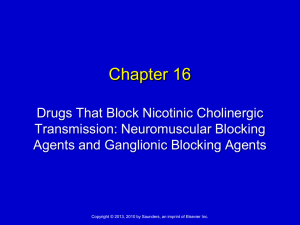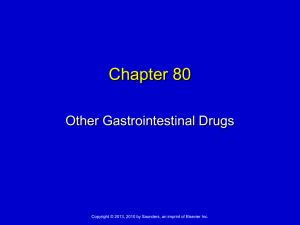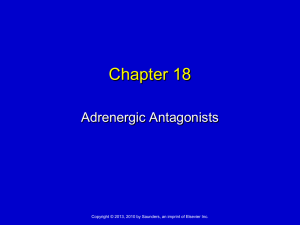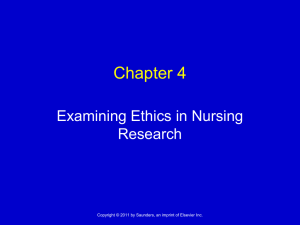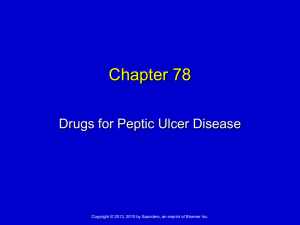Chapter Nine
advertisement
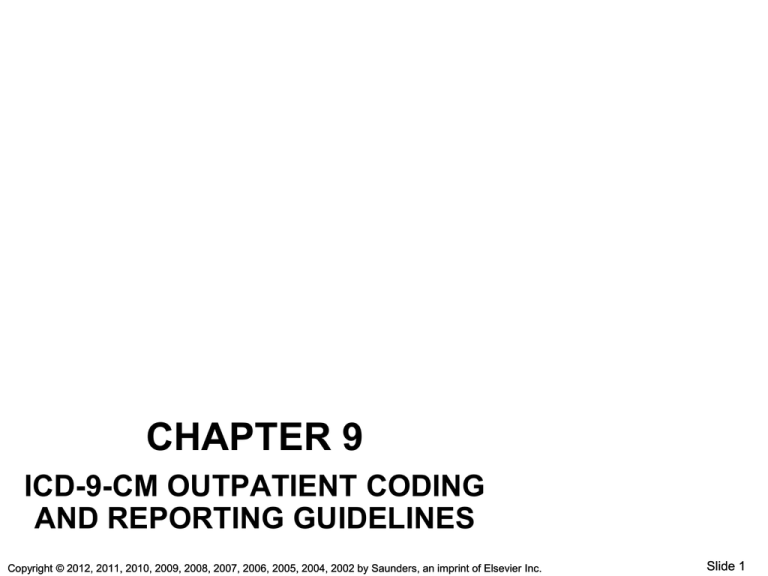
CHAPTER 9 ICD-9-CM OUTPATIENT CODING AND REPORTING GUIDELINES Copyright © 2012, 2011, 2010, 2009, 2008, 2007, 2006, 2005, 2004, 2002 by Saunders, an imprint of Elsevier Inc. Slide 1 Section IV. Diagnostic Coding • Physician’s office • Hospital-based outpatient services • Part of Official Guidelines for Coding and Reporting, Section IV Copyright © 2012, 2011, 2010, 2009, 2008, 2007, 2006, 2005, 2004, 2002 by Saunders, an imprint of Elsevier Inc. Slide 2 Section IV. Diagnostic Coding • Guidelines do not address specific sequencing or diseases as inpatient do • Though not stated, if there is no outpatient guideline, follow inpatient guidelines Copyright © 2012, 2011, 2010, 2009, 2008, 2007, 2006, 2005, 2004, 2002 by Saunders, an imprint of Elsevier Inc. Slide 3 Diagnostic Coding Guideline A • Term first-listed diagnosis, rather than principal diagnosis • Outpatient Surgery: Reason for surgery – Even if surgery is canceled due to contraindication Copyright © 2012, 2011, 2010, 2009, 2008, 2007, 2006, 2005, 2004, 2002 by Saunders, an imprint of Elsevier Inc. Slide 4 Diagnostic Coding Guideline A • Observation Stay: Medical condition that occasioned admission – Assign a code from medical condition • Observation Stay: Complications from outpatient surgery lead to observation report: • Reason for surgery as first reported diagnosis • Codes for complications necessitating observation Copyright © 2012, 2011, 2010, 2009, 2008, 2007, 2006, 2005, 2004, 2002 by Saunders, an imprint of Elsevier Inc. Slide 5 Selection of First-Listed Diagnosis • Condition for encounter – Why patient presented, not necessarily most serious condition noted • Documented • Chiefly responsible for services provided • Also list co-existing conditions Copyright © 2012, 2011, 2010, 2009, 2008, 2007, 2006, 2005, 2004, 2002 by Saunders, an imprint of Elsevier Inc. Slide 6 Diagnosis and Services • Diagnosis and procedure MUST correlate • Medical necessity must be established through documentation • No correlation = No reimbursement Copyright © 2012, 2011, 2010, 2009, 2008, 2007, 2006, 2005, 2004, 2002 by Saunders, an imprint of Elsevier Inc. Slide 7 Symptoms, Signs, and IllDefined Conditions • Can be the first-listed diagnosis if no more specific diagnosis available • Diagnoses often are not established at the time of the initial encounter/visit Copyright © 2012, 2011, 2010, 2009, 2008, 2007, 2006, 2005, 2004, 2002 by Saunders, an imprint of Elsevier Inc. Slide 8 Diagnostic Coding Guideline B • Use codes 001.0 through V91.99 to code: – Diagnosis – Symptoms – Conditions – Problems – Complaints – Or other reason(s) for visit Copyright © 2012, 2011, 2010, 2009, 2008, 2007, 2006, 2005, 2004, 2002 by Saunders, an imprint of Elsevier Inc. Slide 9 Diagnostic Guideline C • Documentation should describe patient's condition, using terminology that includes: – Specific diagnoses – Symptoms – Problems – Reasons for encounter Copyright © 2012, 2011, 2010, 2009, 2008, 2007, 2006, 2005, 2004, 2002 by Saunders, an imprint of Elsevier Inc. Slide 10 Diagnostic Guideline D • Selection of codes 001.0 through 999.9 (Chapters 1-17) frequently used to describe reason for encounter Copyright © 2012, 2011, 2010, 2009, 2008, 2007, 2006, 2005, 2004, 2002 by Saunders, an imprint of Elsevier Inc. Slide 11 Diagnostic Guideline E • Codes that describe symptoms and signs, as opposed to diagnoses, acceptable for reporting purposes when – An established diagnosis has NOT been determined by physician Copyright © 2012, 2011, 2010, 2009, 2008, 2007, 2006, 2005, 2004, 2002 by Saunders, an imprint of Elsevier Inc. Slide 12 Diagnostic Guideline F • V codes deal with encounters for circumstances other than disease or injury – Example: Well-baby checkup • See Section I.C.18. for information on V codes Copyright © 2012, 2011, 2010, 2009, 2008, 2007, 2006, 2005, 2004, 2002 by Saunders, an imprint of Elsevier Inc. Slide 13 Section I.C.18. Classification of Factors Influencing Health Status and Contact with Health Service • V01-V91 – Assigned as first-listed diagnosis for: • Admissions for evaluation • Following an accident that would ordinarily result in health problem, BUT there is none – Car accident, driver hits head, no apparent injury, admit to R/O head trauma – Never a secondary diagnosis Copyright © 2012, 2011, 2010, 2009, 2008, 2007, 2006, 2005, 2004, 2002 by Saunders, an imprint of Elsevier Inc. Slide 14 V Codes • Located after 999.9 in Tabular • Two digits before decimal (e.g., V10.1X) • Index for V codes is Alphabetic Index to Diseases • Main terms: – Contraception – Counseling – Dialysis – Status – Examination Copyright © 2012, 2011, 2010, 2009, 2008, 2007, 2006, 2005, 2004, 2002 by Saunders, an imprint of Elsevier Inc. Slide 15 Uses of V Codes • Not sick BUT receives health care (e.g., vaccination) • Services for known/resolving disease/injury (e.g., chemotherapy) • Codes for “aftercare” (e.g., surgery or fracture) • Indicate birth status/outcome of delivery (Cont’d…) Copyright © 2012, 2011, 2010, 2009, 2008, 2007, 2006, 2005, 2004, 2002 by Saunders, an imprint of Elsevier Inc. Slide 16 Uses of V Codes (…Cont’d) • A circumstance/problem that influences patient’s health BUT NOT current illness/injury – Example: Organ transplant status – Example: Birth status and outcome of delivery (newborn) • Section I.C.18.e. of Guidelines contains the V Code Table – Identifies if V code can be listed as first, first/additional, additional only Copyright © 2012, 2011, 2010, 2009, 2008, 2007, 2006, 2005, 2004, 2002 by Saunders, an imprint of Elsevier Inc. Slide 17 History V Code Categories in Tabular • V10 Personal history of malignant neoplasm • V11 Personal history of mental illness • V12 Personal history of certain other diseases • V13 Personal history of other diseases • V14 Personal history of allergy to medicinal agents • V15 Other personal history presenting hazards to health • V16 Family history of malignant neoplasm • V17 Family history of certain chronic disabling diseases • V18 Family history of certain other specific diseases • V19 Family history of other conditions Condition no longer present or treated Copyright © 2012, 2011, 2010, 2009, 2008, 2007, 2006, 2005, 2004, 2002 by Saunders, an imprint of Elsevier Inc. Slide 18 Diagnostic Guideline G • Codes have either 3, 4, or 5 digits • 4 and/or 5 digit codes provide greater specificity (detail) (Cont’d…) Copyright © 2012, 2011, 2010, 2009, 2008, 2007, 2006, 2005, 2004, 2002 by Saunders, an imprint of Elsevier Inc. Slide 19 Diagnostic Guideline G (…Cont’d) • 3-digit code used ONLY if no 4 or 5 digit • Where 4 and/or 5 digits provided, must be assigned • Diagnoses NOT coded to full digits available invalid • Claims bounce! Copyright © 2012, 2011, 2010, 2009, 2008, 2007, 2006, 2005, 2004, 2002 by Saunders, an imprint of Elsevier Inc. Slide 20 Diagnostic Guideline H • List first code for diagnosis, condition, problem, or other reason for encounter/visit shown in medical record to be chiefly responsible for services provided • List additional codes that describe any coexisting conditions • Assign V72.5 and V72.6X for routine lab/radiology test ordered without signs, symptoms, or associated diagnosis Copyright © 2012, 2011, 2010, 2009, 2008, 2007, 2006, 2005, 2004, 2002 by Saunders, an imprint of Elsevier Inc. Slide 21 Diagnostic Guideline I • Do NOT code diagnoses documented as probable, suspected, questionable, rule out, or working diagnoses • Rather, code condition(s) to suspected highest degree of certainty for that encounter/visit, such as symptoms, signs, abnormal test results, or other reason for visit Copyright © 2012, 2011, 2010, 2009, 2008, 2007, 2006, 2005, 2004, 2002 by Saunders, an imprint of Elsevier Inc. Slide 22 Diagnostic Guideline J • Chronic diseases treated on an ongoing basis may be coded and reported as many times as patient receives treatment and care for condition(s) Copyright © 2012, 2011, 2010, 2009, 2008, 2007, 2006, 2005, 2004, 2002 by Saunders, an imprint of Elsevier Inc. Slide 23 Diagnostic Guideline K • Code all documented conditions that coexist at time of visit, that require or affect patient care, treatment, or management • Do NOT code conditions previously treated, no longer existing (Cont’d…) Copyright © 2012, 2011, 2010, 2009, 2008, 2007, 2006, 2005, 2004, 2002 by Saunders, an imprint of Elsevier Inc. Slide 24 Diagnostic Guideline K (…Cont’d) • “History of” codes (V10-V19) may be used as secondary codes if: – Impacts current care or treatment Copyright © 2012, 2011, 2010, 2009, 2008, 2007, 2006, 2005, 2004, 2002 by Saunders, an imprint of Elsevier Inc. Slide 25 Special Note About “History of” • Index to Disease, MAIN term “History” • Entries between “family” and “visual loss V19.0” = “family history of” (FHO) • Entries before “family” and after “visual loss” = “personal history of” (PHO) • Personal history = V10-V15 • Family history = V16-V19 Copyright © 2012, 2011, 2010, 2009, 2008, 2007, 2006, 2005, 2004, 2002 by Saunders, an imprint of Elsevier Inc. Slide 26 Diagnostic Guidelines L and M • For patients receiving diagnostic services ONLY • Sequence first – Diagnosis – Condition – Problem OR – Other reason shown in medical record to be chiefly responsible for encounter (…Cont’d) Copyright © 2012, 2011, 2010, 2009, 2008, 2007, 2006, 2005, 2004, 2002 by Saunders, an imprint of Elsevier Inc. Slide 27 Diagnostic Guidelines L and M (…Cont’d) • Codes for other diagnoses (e.g., chronic conditions) – May be sequenced as secondary diagnoses • Exception: Therapeutic Services – Patients receiving chemotherapy (V58.11), radiation therapy (V58.0), or rehabilitation (V57.0-V57.9) – V code first diagnosis and problem for which service being performed second Copyright © 2012, 2011, 2010, 2009, 2008, 2007, 2006, 2005, 2004, 2002 by Saunders, an imprint of Elsevier Inc. Slide 28 Diagnostic Guideline N • For patients receiving preoperative evaluations ONLY – Code from category V72.8 (Other specified examinations) – Assign secondary code for reason for surgery – Code also any findings related to preoperative evaluation Copyright © 2012, 2011, 2010, 2009, 2008, 2007, 2006, 2005, 2004, 2002 by Saunders, an imprint of Elsevier Inc. Slide 29 Diagnostic Guideline O, Ambulatory Surgery • Code diagnosis which required ambulatory surgery • Pre- and post-op diagnosis different – Code the post-op diagnosis Copyright © 2012, 2011, 2010, 2009, 2008, 2007, 2006, 2005, 2004, 2002 by Saunders, an imprint of Elsevier Inc. Slide 30 Diagnostic Guideline P • Code routine prenatal visits with no complications: – V22.0 (Supervision of normal first pregnancy) – V22.1(Supervision of other normal pregnancy) – DO NOT use these codes with pregnancy complication codes (Chapter 11, ICD-9-CM) Copyright © 2012, 2011, 2010, 2009, 2008, 2007, 2006, 2005, 2004, 2002 by Saunders, an imprint of Elsevier Inc. Slide 31 V91 Multiple Gestation Placenta Status • New in 2011 • Identifies number of placentas and amniotic sacs for twins, triplets, quadruplets, other multiples Copyright © 2012, 2011, 2010, 2009, 2008, 2007, 2006, 2005, 2004, 2002 by Saunders, an imprint of Elsevier Inc. Slide 32 Conclusion CHAPTER 9 ICD-9-CM OUTPATIENT CODING AND REPORTING GUIDELINES Copyright © 2012, 2011, 2010, 2009, 2008, 2007, 2006, 2005, 2004, 2002 by Saunders, an imprint of Elsevier Inc. Slide 33
